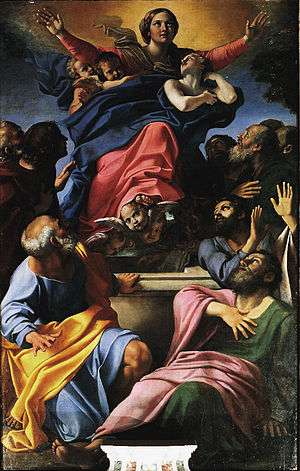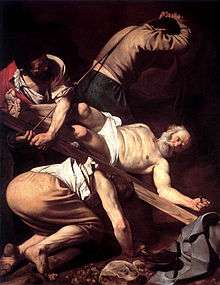Cerasi Chapel
The Cerasi Chapel (Italian: Cappella Cerasi) is one of side chapels in the transept of the Church of Santa Maria del Popolo in Rome. It contains significant paintings by Michelangelo Merisi da Caravaggio and Annibale Carracci, two of the most important masters of Baroque art, dating from 1600-1601.
History
Precursor: Foscari Chapel
Before the present-day edifice another funerary chapel on the same spot was dedicated to the Virgin Mary. It was built by Pietro Foscari, the Cardinal of Venice. Johann Burchard notes in his diary that the cardinal died on 11 August 1485. "His body was then transferred to the city, and given over for burial in a chapel of the Church of Santa Maria del Popolo, which he had built for himself", states Burchard.[1] This construction obviously correlated to the general rebuilding of the basilica by Pope Sixtus IV which began in 1472. The Cardinal of Venice was an influential person in the Roman court and Italian politics. It seems an obvious choice that he built himself a chapel in the Pope's favourite church in a very prominent position in the left transept. The construction might have begun in 1476.
The chapel was covered by a barrel vault with a depth equal to the 15th century arch of the papal chapel. According to the precise will of the patron, the sarcophagus, which was due to host his remains, was placed at the center of the edifice. Due to its particular placement and visibility the sarcophagus was decorated on all four sides. This arrangement was markedly different than the Florentine type wall tombs of the basilica. Probably it was modelled after the tomb of Pope Sixtus IV by Pollaiolo or even more after other 15th century sculptural works in the city of Siena. This sepulchral monument is the only remaining vestige of the demolished chapel. Now it is placed in the Costa Chapel in the right aisle.
The bronze gisant is attributed to a Sienese sculptor, Giovanni di Stefano, a follower of Vecchietta, who was commissioned by the heirs of Cardinal Pietro Foscari and used a funerary mask for the modelling of the face.[2]
Tiberio Cerasi's chapel
The patronage rights of the chapel were purchased on 8 July 1600 by Monsignor Tiberio Cerasi, Consistorial Advocate and Treasurer-General to Pope Clement VIII.[3] He bought the chapel from the Augustinian friars with the option to rebuild and adorn it "in the manner and form" he had wanted to. The edifice was reconfigured by Carlo Maderno.
In September Cerasi commissioned Carracci and Caravaggio, the two leading emerging artists of the day, to provide an altarpiece of The Assumption of Mary (Carracci) and The Conversion of Saint Paul on the Road to Damascus and The Crucifixion of Saint Peter (Caravaggio) for the two side walls. Cerasi's choice of the Assumption for the altar seems straightforward enough, while the Saint Paul and Saint Peter honoured the two Apostles central to the Catholic Church, patrons of Rome as well as the popular Counter-Reformation themes of conversion and martydom. The precedent already existed for this juxtaposition in the Cappella Paolina at the Vatican by Michelangelo.[4]
The first versions of the Caravaggio paintings were rejected by the patron and then Caravaggio painted two paintings in oil instead of cypress panels as it had been formerly stipulated. The story of the rejection of the first versions was recorded by Giovanni Baglione in his 1642 Life of Caravaggio.[5]
Tiberio Cerasi died on 5 May 1601 and was buried in the chapel. In his will he named the Fathers of the Hospital of the Madonna della Consolazione as his heir with the responsibility to complete the unfinished chapel.[6] Annibale's altarpiece was already complete while Caravaggio was paid on 10 November 1601 for his work.[7] The paintings were finally installed in the chapel by a woodworker Bartolomeo in May 1604, and the chapel was consecrated on 11 November 1606.[8]
The chapel was restored in 1851 and 1899 by Antonio Cerasi, count of Monterado.[9]
Description
The oblong shaped chapel consists of a sail-vaulted anteroom and a narrower, barrel-vaulted chancel with the altar which is lit by a lunette window on the back wall. The arched entrance is screened by a colourful marble balustrade. The focus of the architecture is the altar shaped as an aedicule of black and white marble with two Corinthian columns and a broken pediment. The Cerasi coats-of-arms is depicted in the center of the stained glass lunette window.
Caravaggio's dramatically lit and foreshortened paintings are intended to be viewed from the side rather than straight-on, and draw the eye to Carracci's frontally presented Assumption, so that the chapel is aesthetically united despite the very different styles of the two artists. According to Steinberg the light on the Caravaggio paintings comes from the painted heaven on the vault of the anteroom, inhabited by the dove of the Holy Spirit.[10] On the other hand, Varriano claims that the "source" of the light seems to be the clerestory window across the transept.[11]
The chapel is decorated in exuberant Baroque style. The frescos on the short barrel-vault of the chancel depict the Coronation of the Virgin (central medaillon) and the visions of Sts Peter and Paul, Domine quo vadis and Saint Paul Transported to the Third Heaven (side panels), both set in rich gilded stucco frames. The frame of the central medaillon in held by four stucco putti. The intrados of the arch between the chancel and the anteroom is decorated with white-gold stucco panels with two putti holding a wreath in the central one. The stucco decoration on the pillars is similar but the figurative panels are gilded. The lower zone of the walls is covered by polychrome marble slabs. The other surfaces are decorated with dense white-gold floral motifs.
The paintings were executed by Innocenzo Tacconi, an able assistant of Annibale Carracci, and at least the coronation scene was designed by Carracci himself. Iconographically the side panels "relate to the Caravaggio paintings in that they manifest the divine cause of what passes below" them. Similarly the Coronation scene is placed above Carracci's Assumption as a direct continuation. The vault forms a celestial zone in close contact with the three famous paintings below.[10] These relationships indicate that the artists worked in a compositional framework conceived by the patron or even more his friend and artistic adviser, Marchese Vincenzo Giustiniani.
The frescos in the anteroom of the chapel are by Giovanni Battista Ricci da Novara, and depict the Holy Spirit in the central oval medaillon and the Evangelists with their usual symbols and helpful putti. The Doctors of the Church are in the two lunettes. Four golden putti seem to support the vault in the spandrels.
There are tombs on the lateral walls of the anteroom, one for Tiberio Cerasi, the founder of the chapel on the left and another for his father, Stefano Cerasi (†1575) and mother, Bartolomea Manardi on the right (1601). These are typical Baroque funeral wall monuments with the carved busts of the deceased in ovals, curved broken pediments and long epitaphs. The projecting heads are turned towards the altar. The tombs have a painted background with draperies and flaming urns.
Gallery
-

Conversion of Saint Paul (Caravaggio)
-

Assumption of the Virgin Mary (Carracci)
-

Crucifixion of St. Peter (Caravaggio)
-
The chapel from the transept
-
Frescos of Innocenzo Tacconi on the vault
-
Left side wall
-
Right side wall
-
Pavement
Notes
- ↑ The Diary of John Burchard of Strasburg, trans. Arnold Harris Mathew, Vol I. A. D. 1483-1492, London, 1910, p. 110
- ↑ Antonio Foscari: Il cardinale veneziano Pietro Foscari e lo scultore senese Giovanni di Stefano in Santa Maria del Popolo a Roma, in: "Arte Documento", n. 14, Edizioni della Laguna, Gorizia 2000, pp. 59-63
- ↑ Hibbard, Howard (1983). Caravaggio. Westview Press. p. 119. ISBN 0-06-430128-1.
- ↑ Lilian H. Zirpolo, cit., pag. 91.
- ↑ Heather Nolin: "Non piacquero al Padrone: A Reexamination of Caravaggio's Cerasi Crucifixion of St. Peter, in:Rutgers Art Review 24 (2008), p. 41
- ↑ Christopher L. C. E. Witcombe, cit., pag. 22.
- ↑ William Breazeale: «Un gran soggetto ma non ideale»: Caravaggio and Bellori’s legacy, Kunsttexte.de. 1/2001, p. 1
- ↑ Heather Nolin, cit., pag. 48.
- ↑ Raffaele Colantuoni: La chiesa di S. Maria del Popolo negli otto secoli dalla prima sua fondazione, 1099-1899. Storia e arte. 1899
- 1 2 Leo Steinberg, cit., pag. 185.
- ↑ John L. Varriano, cit., pag. 44.
Bibliography
- Leo Steinberg: Observations in the Cerasi Chapel, in: The Art Bulletin, Vol. 41, No. 2 (Jun., 1959), pp. 183–190
- Lilian H. Zirpolo: The A to Z of Renaissance Art, Scarecrow Press, 2008
- John L. Varriano: Caravaggio: The Art of Realism, Penn State University Press, 2006
- Christopher L. C. E. Witcombe: Two "Avvisi", Caravaggio, and Giulio Mancini, in: Source: Notes in the History of Art, Vol. 12, No. 3 (Spring 1993), pp. 22–29
- L. Spezzaferro, "La cappella Cerasi e il Caravaggio," in: Caravaggio, Carracci, Maderno. La Cappella Cerasi in S. Maria del Popolo a Roma (ed. L. Spezzaferro, M.G. Bernardini, C. Strinati, and A.M. Tantillo (Milan 2001), pp. 9-34.
- William Breazeale: «Un gran soggetto ma non ideale»: Caravaggio and Bellori’s legacy, Kunsttexte.de. 1/2001
- William Breazeale: Il Caravaggio, il Carracci e la cappella Cerasi: eredità teorica e opinione moderna Firenze : Le Càriti, 2006.
- Heather Nolin: "Non piacquero al Padrone: A Reexamination of Caravaggio's Cerasi Crucifixion of St. Peter, in: Rutgers Art Review 24 (2008)
| Wikimedia Commons has media related to Santa Maria del Popolo (Rome). |
Coordinates: 41°54′41″N 12°28′35″E / 41.9113°N 12.4764°E